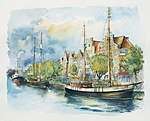Osnabrück
Osnabrück (German pronunciation: [ɔsnaˈbʁʏk] (![]()
Osnabrück | |
|---|---|
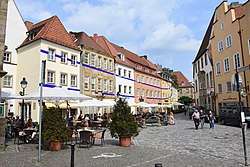 City centre of Osnabrück | |
 Flag  Coat of arms | |
Location of Osnabrück 
| |
 Osnabrück  Osnabrück | |
| Coordinates: 52°17′N 8°3′E | |
| Country | Germany |
| State | Lower Saxony |
| District | Urban district |
| Government | |
| • Lord Mayor | Wolfgang Griesert[1] (CDU) |
| Area | |
| • City | 119.80 km2 (46.26 sq mi) |
| Elevation | 63 m (207 ft) |
| Population (2018-12-31)[2] | |
| • City | 164,748 |
| • Density | 1,400/km2 (3,600/sq mi) |
| • Metro | 272,674 |
| Time zone | CET/CEST (UTC+1/+2) |
| Postal codes | 49074–49090 |
| Dialling codes | 0541 |
| Vehicle registration | OS |
| Website | www.osnabrueck.de |
The founding of Osnabrück was linked to its positioning on important European trading routes. Charles the Great founded the Diocese of Osnabrück in 780. The city was also a member of the Hanseatic League. At the end of the Thirty Years' War (1618–1648), the Peace of Westphalia was negotiated in Osnabrück and the nearby city of Münster.[6] In recognition of its role as the site of negotiations, Osnabrück later adopted the title Friedensstadt ("city of peace"). The city is also known as the birthplace of anti-war novelist Erich-Maria Remarque and painter Felix Nussbaum.
More recently Osnabrück has become well known for its industry. Numerous companies in the automobile, paper, steel and grocery sectors are located in the city and its surrounding area.[7] In spite of the massive destruction inflicted on the city during World War II, the Altstadt (old town) was eventually reconstructed extensively with designs loyal to the original medieval architecture there. Osnabrück was also the home of the largest British garrison outside the United Kingdom.[8] Osnabrück's modern, urban image is enhanced by the presence of more than 22,000 students studying at the University and the University of Applied Sciences.[9] Although part of the state of Lower Saxony, historically, culturally and linguistically Osnabrück is considered part of the region of Westphalia.
Name
The origin of the name Osnabrück is disputed. The suffix -brück suggests a bridge over or to something (from German Brücke = bridge) but the prefix Osna- is explained in at least two different ways: the traditional explanation is that today's name is a corruption of Ossenbrügge (westphalian meaning "oxen bridge"), which is etymologically and historically impossible, because the town is older than this corruption of consonants (documented in 13. century, Osnabrueck was founded in 8. century), but others state that it is derived from the name of the Hase River which is arguably derived from Asen (Æsir), thus giving Osnabrück the meaning "bridge to the gods",[10] and previously Tacitus named people living near the grey river (Hase) Chasuarii. It may also be noted that Osnabrueck is situated on the northern end of the Teutoberg Forest, which until the 19th century was known as the Osning. The way in which the city's name is pronounced can also serve as a means of telling if the speaker is a native of Osnabrück or a visitor: most locals stress the last syllable, while those from elsewhere tend to stress the first one. The city gave its name to the textile fabric of osnaburg (note: "-burg" means borough).
History
| Year | Pop. | ±% |
|---|---|---|
| 780 | 800 | — |
| 1171 | 3,500 | +337.5% |
| 1500 | 6,000 | +71.4% |
| 1646 | 5,500 | −8.3% |
| 1800 | 8,564 | +55.7% |
| 1871 | 23,308 | +172.2% |
| 1900 | 51,573 | +121.3% |
| 1910 | 65,957 | +27.9% |
| 1919 | 85,017 | +28.9% |
| 1925 | 88,911 | +4.6% |
| 1933 | 94,277 | +6.0% |
| 1939 | 99,070 | +5.1% |
| 1946 | 88,663 | −10.5% |
| 1950 | 109,538 | +23.5% |
| 1961 | 138,658 | +26.6% |
| 1970 | 143,905 | +3.8% |
| 1987 | 150,807 | +4.8% |
| 2011 | 154,513 | +2.5% |
| 2018 | 164,748 | +6.6% |
| Population size may be affected by changes in administrative divisions. source:[11] | ||

Medieval
Osnabrück initially developed as a marketplace next to the bishopric founded by Charlemagne, King of the Franks, in 780. Some time prior to 803, the city became the seat of the Prince-Bishopric of Osnabrück. Although the precise date is uncertain, it is likely that Osnabrück is the oldest bishopric in Lower Saxony.
In the year 804 Charlemagne was said to have founded the Gymnasium Carolinum in Osnabrück. This would make it the oldest German Gymnasium school, but the charter date is disputed by historians, some of whom believe it could be a forgery.
In 889 the town was given merchant, customs, and coinage privileges by King Arnulf of Carinthia. Osnabrück was first referred to in records as a "city" in 1147. A decade later, Emperor Frederick Barbarossa granted the city fortification privileges (Befestigungsrecht). Most of the towers which were part of the original fortifications are still visible in the city. Osnabrück became a member of the Hanseatic League in the 12th century, as well as a member of the Westphalian Federation of Cities.
The history of the town in the later Middle Ages was recorded in a chronicle by Albert Suho, one of Osnabrück's most important clerics in the 15th century.
Early Modern age
From 1561 to 1639 there was a considerable amount of social unrest and tension in Osnabrück due to the Protestant Reformation, the Thirty Years' War and also witch hunting. In 1582, during the rule of Mayor Hammacher (1565–1588), 163 women were executed as alleged witches; most of them were burned alive. In total, 276 women were executed, along with 2 men who had been charged with wizardry.
The first Lutheran services were held in Osnabrück in 1543. Over the next century, Lutheranism expanded in the city and several Protestant bishops were elected. However, the Catholic churches continued to operate, and the city never became completely Lutheran. After the Thirty Years' War broke out, a Catholic bishop was elected in 1623, and the city was occupied by troops of the Catholic League in 1628.[12] The Gymnasium Carolinum was upgraded to a Jesuit university in 1632, but the university was closed a year later when the city was taken by Swedish troops and restored to Protestant control.
Peace negotiations took place in Osnabrück and the nearby city of Münster from 1643 to 1648. The twin Treaties of Osnabrück and Münster, collectively known as the Peace of Westphalia, ended the Thirty Years' War. Osnabrück was officially recognized as bi-confessional Catholic and Lutheran. The prince-bishopric would be held alternately by a Catholic bishop and a Lutheran bishop. The Protestant bishop would be selected from the descendants of the Dukes of Brunswick-Lüneburg, with priority given to the cadets of what became the House of Hanover. From 1667, prince-bishop Ernest Augustus, Duke of Brunswick-Lüneburg, built the new baroque palace. His son, George I of Great Britain, died in the palace, at the time residence of his younger brother, prince-bishop Ernest Augustus, Duke of York and Albany, on a travel on 11 June 1727.
In the early 18th century, renowned local jurist and social theorist Justus Möser wrote a highly influential constitutional history of the town, the Osnabrücker Geschichte.[13] Following the Seven Years' War, the town's population fell below 6,000, however an economic revival linked to the linen and tobacco industries caused it to rise again from the 1780s onwards.[14]
19th century
The French Revolutionary Wars brought Prussian troops into the city in 1795, followed by the French in 1803.[15] As a result, the town's population was kept below 10,000 for the whole first decade of the 19th century.[15] The Napoleonic period saw possession of the city change hands several times. Control of Osnabrück passed to the Electorate of Hanover in 1803 during the German Mediatisation, and then briefly to the Kingdom of Prussia in 1806. From 1807 to 1810 the city was part of the Kingdom of Westphalia, after which it passed to the First French Empire. After 1815, it became part of the Kingdom of Hanover.
The town's first railway line was built in 1855, connecting it with Löhne. Further rail connections appeared over the following decades, connecting Osnabrück with Emden from 1856, Cologne from 1871 and Hamburg from 1874.[16] In 1866, Osnabrück was annexed by Prussia after the Austro-Prussian War and administered as part of the Province of Hanover. Growth of the local economy and population was fuelled by expansion in the engineering and textile industries, with the Hammersen Weaving Mill established in 1869 and the Osnabrücker Kupfer- und Drahtwerk metallurgical firm following in 1873.[15] The later 19th century also saw growth in the number of schools and the arrival of electricity and modern sanitation.[17]
20th century
By 1914, Osnabrück had over 70,000 inhabitants.[15] The outbreak of the First World War necessitated food rationing; the Allied blockade and a harsh winter in 1917 led to further shortages.[17] Following Germany's defeat in 1918, a council made up of workers and soldiers took control during the November Revolution, but were replaced by the new Weimar Republic the following year.[18] Similarly to many other German cities, Osnabrück experienced considerable inflation and unemployment in the 1920s, with over 2,000 out of work by 1923 and nearly 14,000 receiving some form of government assistance by 1928.[19]
Politically, Osnabrück in the 1920s was a stronghold of support for the Social Democrats and the Catholic Centre Party. However, in the Reichstag elections of September 1930, the Nazi Party received the greatest percentage of votes in the city (nearly 28%) – a more than seven-fold increase from their electoral performance in Osnabrück two years prior.[20] During the campaigns prior to the two federal elections in 1932, both Adolf Hitler and Joseph Goebbels made well-attended speeches in the city.[21]
Following the Nazis' seizure of power in January 1933, Osnabrück was subjected to the implementation of National Socialist economic, political, and social programmes. These resulted in economic growth for ethnic Germans who did not run afoul of the new regime, and the town went from having over 10,000 unemployed in early 1933 to actually having a labour shortage five years later.[22] However, dissenters, supporters of opposition parties and German Jews (who had experienced centuries of discrimination in the city[23]) did not share in this growth and found themselves discriminated against, imprisoned or forced to close their businesses and leave town.[24] During the World War II, both Jews and Romany were deported to concentration camps and extermination camps en masse.[25]
The war ended for Osnabrück on 4 April 1945, when the XVII Corps of Montgomery's Second Army entered the city with little resistance.[26] By the end of the war the city had been extensively bombed and required major reconstructive programmes following the war's end. Leading Nazis fled the city and the British appointed a new mayor, Johannes Petermann. However, during the allied occupation of Germany a British military governor, Colonel Geoffrey Day was placed in charge of administering the city.[27] Relations between the occupiers and the citizens of Osnabrück were generally peaceful, though tensions existed; some minor fights broke out between British soldiers and local youths and some Osnabrückers resented the relationships that developed between the occupiers and local women.[28] Additionally, the British took over more than seventy homes for their own use by the middle of 1946.[29] Amidst shortages, the black market thrived and became one of the main focuses of police activity.[30]
After World War II West Germany realigned its states; Osnabrück became part of the new state of Lower Saxony in 1946. The British continued to maintain Osnabrück Garrison, a garrison near the city, which at one point was the largest British garrison in the world, housing some 4,000 troops and employing around 500 local civilians.[31] It was the target of a PIRA attack in 1996.[32] Due to budget cuts, the troops were withdrawn in 2008 and the property returned to the local government.[33]
After three centuries, the city finally obtained its university when the government of Lower Saxony established the University of Osnabrück in 1974.
Largest foreign resident groups in Osnabrück as of 31 December 2017:[34]
| Rank | Nationality | Population (31 December 2017) |
|---|---|---|
| 1 | 2,725 | |
| 2 | 2,705 | |
| 3 | 2,025 | |
| 4 | 1,580 | |
| 5 | 1,030 | |
Main sights
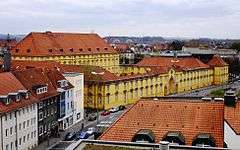
- Town Hall
- St. Peter's Cathedral, founded in the 11th century. It has two façade towers, originally the same size
- Gerdrudenberg Monastery
- Marienkirche
- Heger Tor ("Heger Gate"), a monument to the soldiers from Osnabrück who died at the Battle of Waterloo in 1815
- Bucksturm, the oldest tower in the city, and once part of the city walls. It was once used as a prison for women accused of witchcraft
- Ruwe Fountain" (1985), created to mark the city's 1200th birthday
- Gladiator 2000 (1986), a gigantic painting measuring (45 × 6 meters), by Nicu Covaci
- Felix Nussbaum Haus, a gallery and museum dedicated to the Jewish artist and painter Felix Nussbaum, who died during the Holocaust. It was designed by the architect Daniel Libeskind
- Kalkriese Museum, situated on the battlefield of the Battle of the Teutoburger Wald in the Wiehen Hills, where German tribes under Arminius destroyed three Roman legions. It exhibits artefacts unearthed on the battlefield and tells the story of the battle
- Osnabrücker Schloss (castle[35]/palace[36]) 17th century Baroque construction, nowadays the main building of the University of Osnabrück
- Botanischer Garten der Universität Osnabrück, the university's botanical garden
- Old town with its small streets and medieval buildings
- Osnabrück Zoo
- Vitischanze – formerly a defence station in the north-west of the old city, it has the only undestroyed bridge in Europe with a defence walk below its surface. It is also the site of certain faculty of the University of Applied Science. It was earlier used as a casino
- Haseuferweg
- Katharinenkirche (St. Catherine's Church), which dates back to 1248 and is one of the 150 tallest churches in the world, and also the tallest medieval building in Lower Saxony[37]
- Hyde Park, a traditional music hall established in 1976, a haven of pop music and youth culture[38]
- Leysieffer, a traditional German chocolate producer founded in Osnabrück. The main Leysieffer site is in the city centre
Notable people
Famous Osnabrück personalities include the writer Erich Maria Remarque and painters Friedrich Vordemberge-Gildewart (1899–1962) and Felix Nussbaum. Nussbaum has been honoured by Osnabrück in the form of a museum designed by Daniel Libeskind which opened in 1998; it was designed as a scaled-down version of Libeskind's own Jewish Museum in Berlin. The painter Paul Ehrhardt (1888–1981) with his local sujets was more of regional importance. The poet and scholar Johann Ernst Hanxleden was born in Osnabrück, as were reggae musician Gentleman and DJ Robin Schulz. Victory Records and recording artists Waterdown are also based in Osnabrück.
Actress Birgitta Tolksdorf, who became a well-known figure in American television in the 1970s, as well as stage and screen actor Mathias Wieman (the 1958 recipient of the Justus-Möser-Medaille) were also born in the city. Peter van Pels, the love interest of world-famous diarist Anne Frank, and his parents Auguste van Pels and Hermann van Pels, all hailed from Osnabrück.
Friedrich Clemens Gerke, writer, journalist, musician and pioneer of telegraphy who revised the Morse code in 1848, is another of the city's famous sons. (Gerke's notation is still used today.) Fritz Buntrock, born in the city, was an SS officer at Auschwitz concentration camp and was executed for war crimes. Wilhelm Schitli, also born in the city, was also a Nazi SS concentration camp commandant.
Further notable Osnabrückers are Heinrich Abeken, theologian and Prussian Privy Legation Councillor in the Ministry of Foreign Affairs in Berlin; Justus Möser, jurist and historian of the city; and Hans-Gert Pöttering, former President of the European Parliament. One of the best-known Osnabrückers in recent times is Christian Wulff, Prime Minister of Lower Saxony (2003–2010) and German President (2010–2012).
Other notables include:
.jpg)
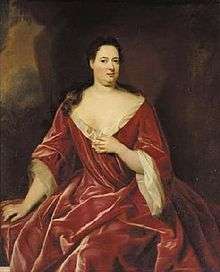
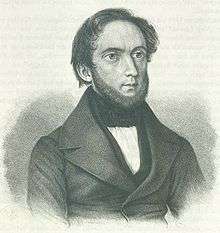
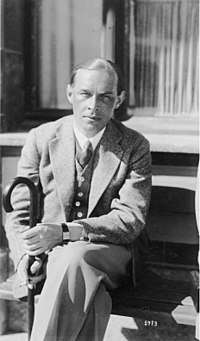
- Albert Suho, (c. 1380–c. 1450), clergyman, theologian, historian
- Gerlach Flicke, (c. 1500–1558), painter
- Friedrich Staphylus (1512–1564) theologian,[39] at first a Protestant and then a Catholic convert.
- Johann Wilhelm Petersen, (1649–1727), evangelical theologian
- John Closterman (1660–1711) portrait[40] painter
- Ernest Augustus, Duke of York and Albany (1674–1728), brother[41] of George I of Great Britain
- Sophia von Kielmansegg, Countess of Darlington (1675–1725) courtier and a half-sister of George I of Great Britain
- Justus Möser (1720–1794) jurist[42] and social theorist
- Ernst zu Münster, (1766–1839), politician, statesman in the service of House of Hannover
- Bernhard Rudolf Abeken, (1780–1866), philologist
- Friedrich Clemens Gerke, (1801–1888), pioneer of telegraphy
- Karl Fortlage (1806–1881) philosopher[43]
- Heinrich Abeken, (1809–1872), evangelical theologian
- August von Kreling, (1819–1876), painter and sculptor
- Friedrich Blass (1843–1907) classical[44] scholar.
- Friedrich Westmeyer, (1873–1917), politician and trade unionist
- Alfred Runge, (1881–1946), architect
- Walter Warlimont, (1894–1976), General of the Artillery
- Erich Maria Remarque, (1898–1970), writer All Quiet on the Western Front
- Mathias Wieman, (1902–1969), actor
- Elfriede Scholz, (1903–1943), victim of national socialism
- Hans Georg Calmeyer, (1903–1972), attorney, Righteous Among the Nations ,
- Felix Nussbaum (1904–1944) surrealist painter, paintings now shown in Felix Nussbaum Haus
- Rudolf Beckmann, (1910–1943), SS-Oberscharführer and war criminal
- Franz Lucas, (1911–1994), concentration camp doctor
- Wilhelm Schitli, (1912–1945) (missing), SS Hauptsturm leader and guardian of the Neuengamme concentration camp
- Herbert Tiede, (1915–1987), actor
- Benno Sterzenbach, (1916–1985), actor
- Hubertus Brandenburg, (1923–2009), Bishop of Stockholm
- Reinhold Remmert, (1930–2016); mathematician
- Jürgen Kühling, (1934–2019), lawyer, former judge at the Federal Constitutional Court
- Ursula Levy (born 1935) American author, child psychologist and Holocaust survivor
- Inge Schmitz-Feuerhake, (born 1935), physicist and mathematician, has assessed the biological effects of ionizing radiation
- Rudolf Seiters, (born 1937), politician (CDU), Vice-President of the Bundestag 1998–2002
- Paul Kirchhof, (born 1943), former judge of the Federal Constitutional Court, prof. of tax law
- Ferdinand Kirchhof, (born 1950), judge at the Federal Constitutional Court, professor of tax law
- Thomas Bellut (born 1955), journalist
- Olaf Scholz (born 1958), politician (SPD)
- Christian Wulff (born 1959) politician and lawyer, President of Germany from 2010 to 2012
- Evelyn Herlitzius (born 1963) opera singer, a dramatic soprano.
- Uwe Figenser, (born 1975), Studentwerk-worker and Superhero in Dodesheide
- Sabine R. Huebner (born 1976) ancient historian
- Robin Schulz, (born 1987), musician, DJ and record producer
Education
There are two higher education institutions in Osnabrück, University of Osnabrück and Osnabrück University of Applied Sciences with more than 25,000 students. All of the types of German grammar schools are represented in the city, including seven Gymnasien. Gymnasium Carolinum claims to be the oldest still existing school in Germany. Another well-known Gymnasium is the Ursulaschule, a private school, located directly opposite the Carolinum. The University of Osnabrück invested heavily in infrastructure to take on more students for the following years.
Transport
The city of Osnabrück is connected by road to the A1, the A30 and the A33. It shares its airport with Münster.
Osnabrück Hauptbahnhof (central railway station) is an important rail travel hub. Travellers from the Netherlands heading to either Hamburg, Denmark, or Eastern Europe often have to change here.
An extensive bus network operated by the Stadtwerke Osnabrück (public utility provider) provides public transport within the city and the surrounding region. The central hub is situated on Neumarkt close to the main shopping street, roughly 10 minutes' walk from the railway station.
Districts of Osnabrück

The city is divided into 23 districts:
|
|
|
Twin towns and sister cities
Osnabrück is twinned with:
|
Twinning with Derby
Osnabrück is twinned with the city of Derby in England.
Previously Osnabrück had made contact with the British authorities as early as 1948, hoping to find an English twin town and therefore achieve greater understanding with their former enemies in the Second World War. Unfortunately, this attempt was unsuccessful and Osnabrück did not actively consider the idea again for another quarter-century. The twinning agreement with Derby was signed on 17 February 1976 in the historic Friedenssaal (Hall of Peace) in Osnabrück's town hall. Every year since then the two towns have exchanged envoys. Derby also has a square named after Osnabrück in honour of the twinning arrangement; this features an obelisk among other things.
Osnabrück now has eleven twin and friendship cities: Derby (England), Angers (France), Haarlem (Netherlands), Çanakkale (Turkey), Tver (Russia), Greifswald (Germany), Vila Real (Portugal), Hefei (China), Evansville (USA), Gmünd (Austria), Gwangmyeong (Korea) and there are five envoys working at the twinning office in Osnabrück, who represent Derby, Angers, Haarlem, Tver and Çanakkale.
Every year, Derby and Osnabrück each appoint an envoy who spends twelve months in their respective twin city. The envoy's role is varied, but primarily focuses on promoting the exchange of ideas between the two cities, as well as acting as an educational and general information officer to promote awareness of the twinning scheme. The envoy's specific duties are numerous: translating, giving talks and presentations to local societies and schools, finding pen friends and short-term host families during work placements, working in day-to-day contact to assist groups who want to get involved in twinning by identifying and approaching possible counterparts, planning the Derby Day at the annual Maiwoche (May Week) festival, and many more.
The exchange of envoys between two cities is very unusual. The team of envoys in Osnabrück changes every year and Osnabrück also sends envoys to Derby, Angers and Çanakkale. No other city in Germany participates in this exchange of envoys, and in Britain, only one other city, Wigan, receives and sends an envoy.
The twinning gives the inhabitants of both places the opportunity to interact with their international neighbours. Town twinning aims to enhance international understanding and break down social barriers.
See also
- Ossensamstag - annual parade
- Steckenpferdreiten
- Straße der Megalithkultur, tourist route from Osnabrück to Oldenburg via some 33 megalithic sites
References
- Hinrichs 2013.
- Landesamt für Statistik Niedersachsen, LSN-Online Regionaldatenbank, Tabelle 12411: Fortschreibung des Bevölkerungsstandes, Stand 31. Dezember 2018.
- "Osnabrück AKTUELL 4/2016" (PDF) (in German). Stadt Osnabrück. April 2016. Retrieved 16 June 2017.
- Team Strategische Stadtentwicklung und Statistik 2013, p. 1.
- Osnabrück: Lebendiges Zentrum im Osnabrücker Land www.osnabruecker-land.de
- Friedensstadt Osnabrück: Der Westfälische Friede
- "Staedtereport_Osnabrueck_okt_2009.pdf (application/pdf-Objekt; 106 kB)" (PDF). Archived from the original (PDF) on 9 February 2015. Retrieved 3 May 2015.
- Hall, Allan (12 July 2008). "Garrison town fears slump as army pulls out". The Guardian.
- "Stadtporträt: Osnabrück stellt sich vor".
- "Environmental Education at the University of Osnabrück" (in German). Umweltbildung.uni-osnabrueck.de. Retrieved 6 June 2020.
- Link
- Greengrass, Mark (2014). Christendom Destroyed: Europe 1517–1648. ISBN 9780698176256.
Both cities carried the scars o the war, but Osnabrück suffered worse, subjected to the troops of the Catholic League (1628-32) and a forcible Catholicization, and then Swedish war contributions.
- Panayi 2007, pp. 15–16.
- Panayi 2007, p. 15.
- Panayi 2007, p. 16.
- Panayi 2007, p. 16-17.
- Panayi 2007, p. 17.
- Panayi 2007, p. 17-18.
- Panayi 2007, p. 18.
- Panayi 2007, p. 37.
- Panayi 2007, p. 44.
- Panayi 2007, p. 55.
- "OSNABRÜCK". jewishencyclopedia.com.
- Panayi 2007, p. 23-24,81, 186–200.
- Panayi 2007, p. 197-98,211.
- Panayi 2007, p. 137.
- Panayi 2007, p. 135,137.
- Panayi 2007, p. 136-37.
- Panayi 2007, p. 150-51.
- Panayi 2007, p. 153-56.
- "IOE Archives". Archive.ioe.ac.uk. Retrieved 1 January 2014.
- Geraghty, Tony (2000). The Irish War. Johns Hopkins University Press, p. 193. ISBN 0-00-255617-0
- "British soldiers march out of Osnabrück after 63 years". The Local. 19 July 2008.
- "Bevölkerungsaufbau 2013 und Bevölkerungsveränderungen" (PDF). Stadt Osnabrück. Retrieved 25 July 2014.
- Retrieved 26 May 2015
- p.19. Retrieved 26 May 2015
- "Höchstes mittelalterliches Bauwerk Niedersachsens". Osnabrück civic site. Retrieved 7 November 2011.
- Hyde Park-Memories Archived 6 April 2012 at the Wayback Machine Retrieved 13 December 2011
- . Catholic Encyclopedia. 14. 1912.
- . Dictionary of National Biography. 11. 1887.
- . Dictionary of National Biography. 17. 1889.
- . Encyclopædia Britannica. 18 (11th ed.). 1911.
- . Encyclopædia Britannica. 10 (11th ed.). 1911.
- . Encyclopædia Britannica. 04 (11th ed.). 1911.
References
- Hinrichs, Wilfried (8 October 2013), "Der neue Oberbürgermeister hat "Ja" gesagt", Neue Osnabrücker Zeitung (in German), retrieved 1 October 2013
- Panayi, P. (2007), Life and Death in a German Town: Osnabrück from the Weimar Republic to World War II and Beyond, New York: Tauris Academic Studies ISBN 978-0-85771-440-4
- Team Strategische Stadtentwicklung und Statistik (August 2013), 02001 Amtliche Einwohnerzahlen der Stadt Osnabrück und der angrenzenden Gemeinden Stand: Volkszählung 25.5.1987 und jeweils 31.12. (PDF) (in German), City of Osnabrück, p. 1, retrieved 1 January 2014
Further reading
- Gerd Steinwascher (editor): Geschichte der Stadt Osnabrück Meinders & Elstermann, Belm 2006, ISBN 3-88926-007-1
- Bettina Meckel: Osnabrück und Umland. Wenner, Osnabrück, 2010. An excellent picture book includes translation to English by Nick Woods. ISBN 978-3-87898-417-7
- John M. Jeep, ed. (2001). "Osnabruck". Medieval Germany: an Encyclopedia. Garland Publishing. ISBN 0-8240-7644-3.
External links
| Wikimedia Commons has media related to Osnabrück. |
| Wikivoyage has a travel guide for Osnabrück. |
| Wikisource has the text of the 1879 American Cyclopædia article Osnabrück. |
- Official website

- Panoramas and virtual Tours of Osnabrück
- Horses & Dreams Annual Horse Dressage Show
- Independent Film Festival Osnabrueck official website Unabhaengiges FilmFest Osnabrueck
- The Ostensibles English Theatre in Osnabrueck, official website
- . Encyclopædia Britannica (11th ed.). 1911.
- Derby and Osnabrück Facebook page (retrieved 15/01/2015)
- Derby City Council website, Town Twinning page. (retrieved 15/01/2015)

